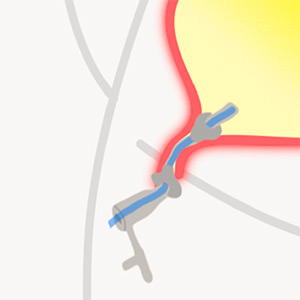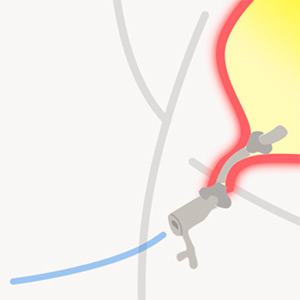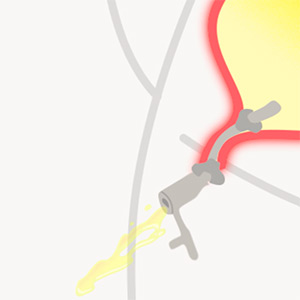Article in Journal of Pediatric Urology
New device for bladder intermittent emptying in female children and adolescents: a pilot study

Vilar Cath is a device with the ability to stop the cycle of leaks, diseases and dependence generated by incontinence and female urinary retention.The catheter has an exclusive sealing technology which is easily manipulable in giving patients the complete control over the act of urinating.It replaces the exhausting treatment with CLEAN INTERMITTENT CATHETERIZATION (CIC) and reduces or even eliminates the use of diapers.
Being made with silicone medical grade, it is hypoallergenic, versatile, malleable and resistant to heat, water and action of oxidants.The probe (which is indicated for children, adults and the elderly) is placed by the doctor through an outpatient procedure, without surgery and done within a few minutes. Thus,it remains in the body for up to two months.Its use provides a full and limited routine with improvement of all quality of life indicators by up to 80% alongside expressive positive effect on the organism and the social circle of women.
The upper end of the catheter, introduced into the base of the bladder (bladder neck), contains seven holes which have been designed to drain urine.
The upper disc is fixed, being malleable, presenting a variable diameter and it is in the inlet of the bladder neck to seal the urine passage out of the probe.
The central body of Vilar Cath has three available models between the discs (3cm, 4cm, 15cm) to suit the anatomy of any patient.The catheter diameter is 14 FR (4.67mm).
The lower disc has a diameter of 17 mm;furthermore, it is malleable, mobile and can be slipped to adjust to the external urethral meatus (external orifice)
The lower end of the probe has a tapered structure. It is closed by an occlusion mechanism attached to an ultrasound connector through which the patient controls the output of the urine.
Studies which have been carried out in order to test the effectiveness of the probe found the decrease of 50% regarding the registration of hematurias, bruises, avulsions, calcifications and fistulas compared to the results obtained from conventional treatment. Half of the assessed patients did not even presented occurrences.
Vilar Cath reduced the episodes of urinary infection by up to 80%, partially being a consequence concerning the disposal of waste from the simulated physiological process and ease of use anywhere (unlike CLEAN INTERMITTENT CATHETERIZATION, CIC, local-dependent and specific conditions to be executed).

Vilar Cath reduces up to 80% the occurrence of infections and even eliminates adverse reactions
Clinical studies which have been carried out with Vilar Cath users found to improve up to 40% in cystometric capacity (expanded from 202 ml to 282 mL).
The results are higher than the index obtained by women submitted to CIC during evaluation. CIC patients presented 7% of positive variation which is considered statistically insignificant (203 ml to 217 mL).
Reflections on cistometric capacity are related to the reduction of urinary loss and increased functional aspect.

Patients who have been treated with Vilar Cath presented an increase in cystometric capacity.
Improving urodynamic aspects extends to the vesical complacency of women treated with Vilar Cath. The use of the probe increased by 111% (from 9 to 19) the function in the evaluated group, a level that stands above the indexes registered with the CLEAN INTERMITTENT CATHETERIZATION (CIC).
CIC patients showed a 14% drop in parameters (regressed from 14 to 12) which have been evaluated. The verified result corroborated previous studies whose conclusions point out to the existence of a reciprocal relationship between recovery of cystometric capacity and the improvement of vesical complacency.
The involuntary leak of urine may lead women to have unpleasant odor and inhibits confidence to be in public environments. The consequences are seclusion, isolation, low self-esteem and even depression.
Vilar Cath is effective in containment and control of urine and it allows children to attend school just as it permits adults to leave home, work and have relationships.
The answers to the SF-Qualiveen questionnaire attested the improvement of up to 80% concerning life indicators among Vilar Cath patients in regards to fear, limitation, feelings and impact on daily life.

The probe rescues self-esteem and confidence of patients to attend public spaces of coexistence.
Women who suffer from urinary incontinence complain of problems regarding sexual intercourse due to leaking urine on partners and that causes frustration. Many individuals break up their relationships and avoid new contact due to fear of further constraints.
Adult patients mentioned the improvement of sexual life as one of the main indicators pertaining to the benefits caused by the probe, both by functionality and physical characteristics. It is effective in urinary containment since it draws away the presence of liquid and the characteristic odor. Furthermore, it presents a discreet setting, unable to disturb the moment of intimacy.

Vilar Cath eliminates the main obstacles of patients to maintain sexual intercourse without fear.
Diapers are required accessories for patients who suffer from urinary incontinence. However, the preventive item is expensive and it does not impede unfortunate odors nor the physical and psychological inconveniences. Patients who are under traditional treatment make up to 8 daily bladder emptying sessions and need to use dozens of diapers per month.
The leak prevention system of Vilar Cath manages to decrease and even eliminate the need for diapers. In the study, the average daily use of the item dropped from 7 to 2 – moreover, among the CIC patients, it oscillated from 7 to 5.

The use of Vilar Cath can eliminate the need for diapers and avail economy towards the treatment of urinary incontinence.
* Compared with CLEAN INTERMITTENT CATHETERIZATION, according to research registered under the number 33116814.9.0000.5208 in the National Research Ethics Commission of Brazil




New device for bladder intermittent emptying in female children and adolescents: a pilot study
Evaluation of the self-sustainable permanent urethral probe for blinking vesical emptying in female patients with neurogenic bladder carriers: randomized clinical trial, phase II
A new bladder emptying method in women with neurogenic bladder: a randomized phase II study